|
Mexican-American
Tent Shows—
A Family Affair
by Bob Brooke
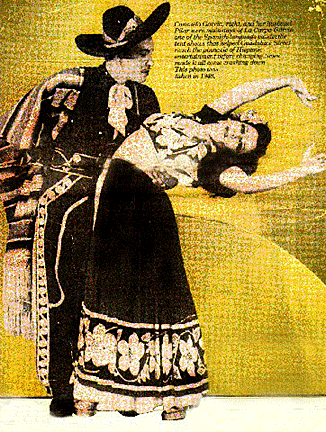 The U.S.-Mexico Border region
is full of stories about immigrant families who came north from Mexico
to find a better life in the United States. One such family was the
Garcias, a family of circus performers who fled Mexico after family
member Victoriano Huerta was deposed from his brief reign as President
of Mexico during the Mexican Revolution in 1914. The U.S.-Mexico Border region
is full of stories about immigrant families who came north from Mexico
to find a better life in the United States. One such family was the
Garcias, a family of circus performers who fled Mexico after family
member Victoriano Huerta was deposed from his brief reign as President
of Mexico during the Mexican Revolution in 1914.
Manuel V. Garcia and his wife, Teresa, formed La Carpa Garcia, a small
traveling tent show—carpa is Spanish for tent—in 1914. They
brought their talent and circus acts to the poor people of the
communities, entertaining them for more than 30 years. During this
period, they traveled and performed in Southern California, New Mexico,
Arizona, and Texas. The show eventually settled in San Antonio and
toured throughout South Texas.
La Carpa Garcia
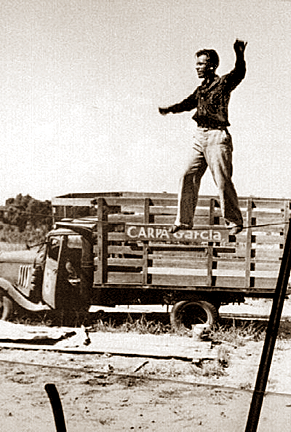 La Carpa García, known in English as the García Brothers Show, was a
Mexican American carpa that performed until 1947. Carpa García consisted
of performers from several families, including Manuel V. and Teresa
García, Manolo and Florinda García, Raymond and Virginia García, Rodolfo
García, Consuelo and Pilár García, Esther García Robinson, Esperanza,
and Aida García Castro and husband, Alfredo. Teresa García also had
three talented children, Rafael, Juan, and Gilberta, from her previous
marriage. La Carpa García, known in English as the García Brothers Show, was a
Mexican American carpa that performed until 1947. Carpa García consisted
of performers from several families, including Manuel V. and Teresa
García, Manolo and Florinda García, Raymond and Virginia García, Rodolfo
García, Consuelo and Pilár García, Esther García Robinson, Esperanza,
and Aida García Castro and husband, Alfredo. Teresa García also had
three talented children, Rafael, Juan, and Gilberta, from her previous
marriage.
Pilar Garcia also came to the U.S. in 1914 and toured with another
famous tent show, La Carpa Cubana, before joining La Carpa Garcia. Pilar
perfected and performed a very dangerous high wire act that made him
famous in the circus community. His wife, Consuelo, also performed as a
singer, dancer and acrobat.
The tent shows, usually run by one family and featuring a mix of bawdy
stage comedy, traditional Mexican song and dance, acrobatics and
clownery, featured performers dressed in sequined and embroidered
costumes, much like those in traditional circuses.
History of the Carpas
The concept of the carpa evolved from the acrobatic and clown
tradition of the Aztecs. Before the carpas, companies of tumblers
called maromas toured Mexico, entertaining at bullfights. In the
late 19th century, European circuses toured Mexico, bringing new acts.
Not to be outdone, the Mexicans formed carpas combining their
ancient traditions with modern circus elements.
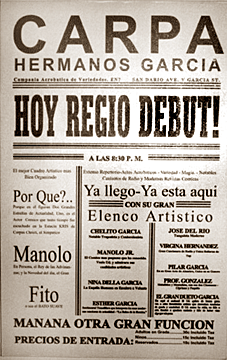 The name, carpa, refers to a portable structure with a canvas
roof, such as other circuses used for touring towns and cities. Unlike
classical circuses, carpas represent a mixture of simple humorous
or satirical performances, as well as those featuring traditional music.
They began in Mexico City and spread to other cities, replacing the
"theater of the rich," whose functions had little or nothing to do with
ordinary people and whose ticket prices were out of reach for most.
Early carpas in Mexico City featured vaudeville, burlesque and
flimflam artists from both sides of the border. The name, carpa, refers to a portable structure with a canvas
roof, such as other circuses used for touring towns and cities. Unlike
classical circuses, carpas represent a mixture of simple humorous
or satirical performances, as well as those featuring traditional music.
They began in Mexico City and spread to other cities, replacing the
"theater of the rich," whose functions had little or nothing to do with
ordinary people and whose ticket prices were out of reach for most.
Early carpas in Mexico City featured vaudeville, burlesque and
flimflam artists from both sides of the border.
In their simplest form, especially following the Mexican Revolution,
carpas consisted of a family with a dilapidated truck filled with
tarps, ropes, planks, and such that some of the locals helped unload.
They created a simple stage and seating area with wooden folding chairs.
People stopped to see what was going on and thus the show built its
audience. They often asked the local padre to announce the artists
presented in each act.
The San Antonio Ledger first recorded the presence of Mexican circuses
in Texas on November 8, 1852. By the time they got to the state, the
big-top Mexican circuses had incorporated some aspects of the Italian,
English, and United States circuses, most notably the English clown with
baggy pants and red wig. The carpa, an unpretentious form of
entertainment that developed in Mexico to entertain the poor, was also
part of the Mexican circus tradition introduced in Texas. Over time, it
outlasted the traditional circus.
 During the first half of the 20th century, such Mexican circuses as
Teatro Carpa Independencia, Circo Cubano, and Carpa García, the most
famous of the three, made San Antonio their home base, and the city
became the hub of both the big-top circuses and the carpas. The
carpas regularly offered entertainment in rural South Texas in the 1920s
and 1930s. The Mexican tent shows became an important part of Tejano
(Tex-Mex) culture in South Texas. During the first half of the 20th century, such Mexican circuses as
Teatro Carpa Independencia, Circo Cubano, and Carpa García, the most
famous of the three, made San Antonio their home base, and the city
became the hub of both the big-top circuses and the carpas. The
carpas regularly offered entertainment in rural South Texas in the 1920s
and 1930s. The Mexican tent shows became an important part of Tejano
(Tex-Mex) culture in South Texas.
In 1912, the family of Ysavel Monsivais, who crossed the border to
escape the Mexican Revolution, formed Carpa Monsivais and toured until
the late 1940s. La Carpa Cubana toured the southwest from 1920 to the
1930s. Founded by Virgilio and Federica Abreu, members of a famous Cuban
circus family who lived in Mexico, they brought their show north to the
U.S.
While on the road, the carperos or members of the carpas
had to function as a small business, meeting payrolls, getting city
permits and keeping equipment maintained. They constantly had to replace
tent parts, worn lumber, and costumes. And even ordered candy to serve
during the show.
La Carpa Comes to Town
The show began with the arrival of a truck full of equipment. Locals
helped unload in a neighborhood plaza or street, then helped erect a
modest tent with a floor that could accommodate up to 100 spectators.
Makeshift dressing rooms were behind a small stage. Some carpas
had larger tents that hold up to 200 people and probably a better
backstage arrangement.
 Most of the carpas, especially at the beginning, presented mostly
comedians, dancers and singers, and sometimes a magician and juggler or
ventriloquist. Shows consisted of three acts. The first was for people
of all ages, including children, and featured lesser-known artists. The
second increased the quality of the show while the third, held after 8
P.M. was the main act and featured noted comic characters and performers
such as Cantinflas and Manuel Medel. Most of the carpas, especially at the beginning, presented mostly
comedians, dancers and singers, and sometimes a magician and juggler or
ventriloquist. Shows consisted of three acts. The first was for people
of all ages, including children, and featured lesser-known artists. The
second increased the quality of the show while the third, held after 8
P.M. was the main act and featured noted comic characters and performers
such as Cantinflas and Manuel Medel.
The crowd, composed of mostly workers and employees, journalists and art
critics, arrived with the expectation of seeing musical numbers with a
minimum of singers in costumes and political satire expressed by
characters like the neighborhood drunk, and a lot of rogues who
ridiculed politicians, and who always put the ingenuity of lower-class
characters above upper class ones.
Those attending the shows also had the opportunity to meet the artists,
singers and comedians that they heard on the radio, as well as beautiful
starlets that delighted them with their colorful costumes full of
sequins and feathers. Members of the audience often interacted with the
performers with jokes and shouts.
The Show
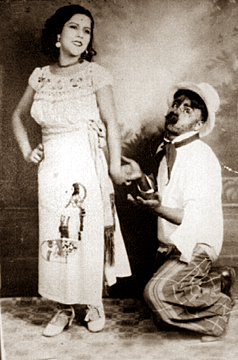 While the carpas presented traditional circus acts in the
pista or ring, they performed comedy and burlesque acts on a small
stage. And though larger shows had trained dogs and horses, none had
side shows or freaks or large animal acts like traditional circuses. While the carpas presented traditional circus acts in the
pista or ring, they performed comedy and burlesque acts on a small
stage. And though larger shows had trained dogs and horses, none had
side shows or freaks or large animal acts like traditional circuses.
Folkloric dances from other countries also separated the carpas
from traditional circus shows. Though dances from Mexico, such as "El
Jarabe Tapatio" or the Mexican Hat Dance, were popular, the carpas
also performed dances from Japan, Germany and Holland, as well as the
Charleston and Jitterbug.
The carpas, which were most popular among working class Texas
Mexicans, combined traditional circus routines with theatrical
traditions by mixing acrobatics, pantomime, clowning, singing and
dancing, comedy routines, and dramatic monologues. They also introduced
important stock characters, the most important of which was the
pelado or underdog, who engaged the audience with hilarious sketches
dealing with treacherous
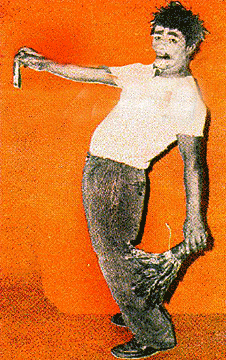 political schemes and other human foibles and
scandals. The pelado also delivered sardonic comments on Tejano
social life and used his wits to survive. He symbolized the audience's
struggles with racial discrimination and acculturation. Two notable
pelados who represented the Tejanos' situation were called Don Slico, or
Mr. Slick, and El Bato Suave, the Smooth Guy. Beatriz Escalona Pérez,
the noted comedienne, created a female equivalent in the late 1920s. political schemes and other human foibles and
scandals. The pelado also delivered sardonic comments on Tejano
social life and used his wits to survive. He symbolized the audience's
struggles with racial discrimination and acculturation. Two notable
pelados who represented the Tejanos' situation were called Don Slico, or
Mr. Slick, and El Bato Suave, the Smooth Guy. Beatriz Escalona Pérez,
the noted comedienne, created a female equivalent in the late 1920s.
For the carpas, the family was all important, as it is in all
Hispanic cultures. Ties were strong and everyone participated to make
the show a success. Most carperos had to be able to perform at
least four acts to replace performers in a pinch.
The carpas outlasted the more established circuses, as well as
the Great Depression. They lasted into the late 1940s because they
offered their audiences both temporary escape from, and an understanding
of, their daily experiences.
<
Back to More Special Features
Next Article >
|
